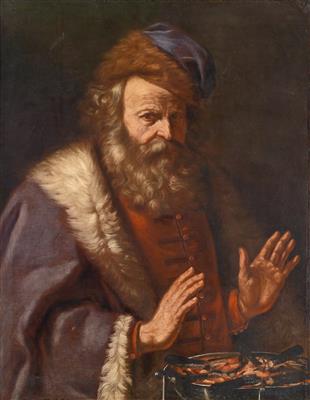Giuseppe Maria Galleppini

(active in Forlí, 1625 – c. 1653), An allegory of winter,
oil on canvas, 98 x 79 cm, framed
Giuseppe Maria Galeppini was a member of a noble family of Forlì who trained with Guercino’s brother-in-law, Bartolomeo Gennari. In 1649, Galeppini was among a select group of studio assistants, including Bartolomeo, that accompanied Guercino to Sassuolo, where the Duke of Modena had invited the painter. More than half of Galeppini’s small surviving oeuvre consists of replicas and variants of Guercino’s paintings. This previously unknown example is among the most ingenious of these adaptations. Galeppini’s Allegory of Winter is derived, with variants, from Guercino’s half-length Isaiah, painted in 1648, now in a private collection, and this connection suggests the Allegory of Winter must date from the same time, or shortly afterwards (see L. Salerno, I dipinti del Guercino, Rome, 1988, p. 327, no. 255). In each work, one half of the protagonist’s face is strongly illuminated, while the other remains in shadow; as a result, the illumination on the side of the nose is emphatically contrasted with an area of dark. The resemblance between the two canvases is not simply in the head, half turned to the right, but also in the hands, which both figures hold up in front of them, the left raised slightly higher than the right.
24.06.2015 - 15:00
- Stima:
-
EUR 5.000,- a EUR 7.000,-
Giuseppe Maria Galleppini
(active in Forlí, 1625 – c. 1653), An allegory of winter,
oil on canvas, 98 x 79 cm, framed
Giuseppe Maria Galeppini was a member of a noble family of Forlì who trained with Guercino’s brother-in-law, Bartolomeo Gennari. In 1649, Galeppini was among a select group of studio assistants, including Bartolomeo, that accompanied Guercino to Sassuolo, where the Duke of Modena had invited the painter. More than half of Galeppini’s small surviving oeuvre consists of replicas and variants of Guercino’s paintings. This previously unknown example is among the most ingenious of these adaptations. Galeppini’s Allegory of Winter is derived, with variants, from Guercino’s half-length Isaiah, painted in 1648, now in a private collection, and this connection suggests the Allegory of Winter must date from the same time, or shortly afterwards (see L. Salerno, I dipinti del Guercino, Rome, 1988, p. 327, no. 255). In each work, one half of the protagonist’s face is strongly illuminated, while the other remains in shadow; as a result, the illumination on the side of the nose is emphatically contrasted with an area of dark. The resemblance between the two canvases is not simply in the head, half turned to the right, but also in the hands, which both figures hold up in front of them, the left raised slightly higher than the right.
|
Hotline dell'acquirente
lun-ven: 10.00 - 17.00
old.masters@dorotheum.at +43 1 515 60 403 |
| Asta: | Dipinti antichi |
| Tipo d'asta: | Asta in sala |
| Data: | 24.06.2015 - 15:00 |
| Luogo dell'asta: | Wien | Palais Dorotheum |
| Esposizione: | 18.06. - 24.06.2015 |
